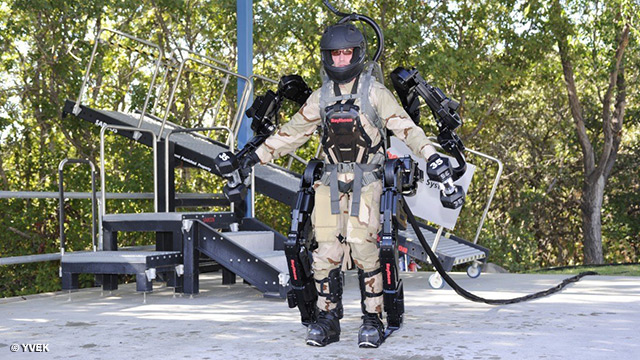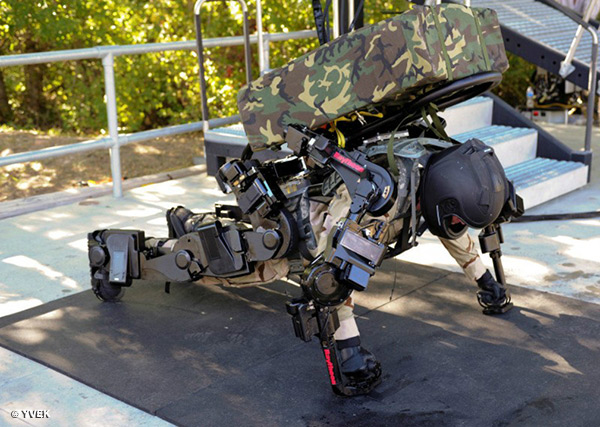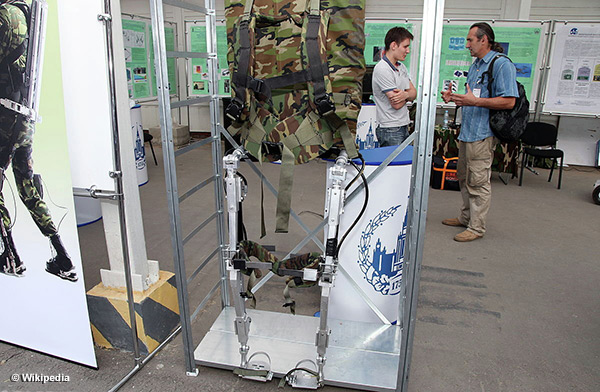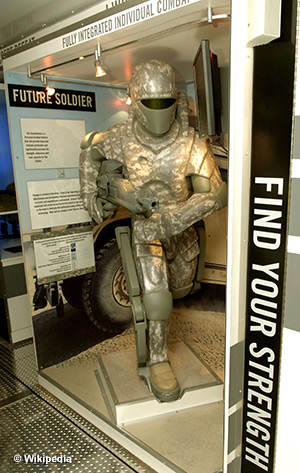WWIII could be fought with robotic exoskeletons; Russia, US compete to develop military exoskeletons
Wednesday, July 01, 2015 by: J. D. Heyes
Tags: robotic exoskeletons, WWIII, Russia

- “Sudden death” COVID vaccine paper published, then censored, by The Lancet now republished with peer review
- Dark secrets exposed: CIA is behind Deagel’s shocking 2025 depopulation forecast & official excess death figures in the millions prove it’s on target & not just an estimation
- Federal court filing exposes MAJOR FRAUD in “sale of Infowars to The Onion
- Top emergency water storage tips for preppers
- Trump confirms a national emergency is coming so he can carry out mass deportations with the help of the U.S. military
- "Disinformation Dozen" smear campaign authors at the CCDH are now under investigation by Congress
- Southwest Airlines jet hit with GUNFIRE at Dallas Love Field Airport in bizarre shooting
- Vaccine stocks plummet after RFK Jr. nominated as HHS secretary
- Clearly staged “neo-Nazi” march through Columbus, Ohio, aims to catalyze more antisemitism speech laws
- Elon Musk’s X dips its fingers into InfoWars’ bankruptcy case
- Susie Wiles, Trump’s pick for chief of staff, ran P.R. campaigns for GAVI, the Vaccine Alliance, Gilead, Pfizer, and long list of globalist companies
- Donald Trump names John Ratcliffe as CIA director
- China’s new hypersonic weapon could tip the scales in future conflicts in Taiwan and the South China Sea
- Scientific American editor resigns following her social media posts criticizing Trump supporters as “fascists” and “bigoted”
- Trump names Tulsi Gabbard to be the next Director of National Intelligence
- Mike Huckabee, Trump’s pick for U.S. ambassador to Israel, believes “there’s no such thing as a Palestinian”
- Tarragon: Versatile ancient herb with science-backed health benefits
- Donald Trump nominates Robert F. Kennedy Jr. as HHS secretary, giving him control over the FDA, CDC, NIH and other agencies
- New Zealand cardiologists concede the simple truth: Spike protein generated by mRNA COVID vaccines is a CARDIOTOXIN
- RFK Jr. says Bill Gates, Fauci will both be arrested under Trump
- Dutch health minister admits that COVID-19 was a "military operation" involving NATO
- Natural News announces list of most important objectives RFK, Jr. must consider as head of HHS
- Opposition to vaccines constitutes “antisemitism and the targeting of Jewish biomedical sciences at its core,” claims Jerusalem Post
- Chinese drone maker DJI sues Defense Department over inclusion in ChiCom military company list
- Trump releases “single most important video on the internet today” about how to rid world of deep state tyranny
- The forgotten holocaust: 20 million Christians SLAUGHTERED by Bolsheviks of former Soviet Union, many of whom were JEWS
- Fed pulls half of credit available from BTFP, engineering a potential banking crash to be thrown in Trump’s lap
- Pharmaceutical narratives surrounding the "flu" are based on fraud and are primarily designed to sell worthless vaccines
- Spain cancels $6.48M arms deal with Israeli defense company amid ongoing IDF violence inflicted upon Gazans
- The history of the House of Rothschild
- Biden urges Ukraine to hit North Korean troops that its military encounters on the battlefield
- POLL: Trump takes narrow lead against Harris in Pennsylvania
- White House legalizes all gain-of-function research to build more BIOWEAPONS
- CBP officer sentenced to 23 years in jail for BRIBERY and facilitating TRAFFICKING
- Newly elected Canadian Liberal premier vows to expand abortion access in her province as soon she is sworn into office
- The government is not going to ride in on a white horse to save you when global events hit the fan
- ANALYSIS: Trump is going to win BIG, and then the real fireworks begin… America won’t survive as we know it for even ONE YEAR
- The history of the House of Rothschild
- Opposition to vaccines constitutes “antisemitism and the targeting of Jewish biomedical sciences at its core,” claims Jerusalem Post
- Top 12 NEW "SYNDROMES" created by insidious government forces, Big Pharma and their propaganda-purporting media complex
- The ugly, horrifying history of Israel’s military, the “most moral army in the world”
- White House legalizes all gain-of-function research to build more BIOWEAPONS
- The forgotten holocaust: 20 million Christians SLAUGHTERED by Bolsheviks of former Soviet Union, many of whom were JEWS
- Pharmaceutical narratives surrounding the "flu" are based on fraud and are primarily designed to sell worthless vaccines
- Hysterical, power-hungry EPA will require all property owners to have "no detectable level of lead dust in the air" - an impossible feat
- JOE ROGAN interviews TRUMP: The likely next POTUS directly addresses NUTRITION and HEALTH
- Israel claims there are secret tunnels filled with gold under Lebanese hospital - but it’s all a hoax to justify bombing civilian infrastructure
- Pfizer knew about serious adverse events linked to COVID-19 vaccines but pushed the jabs on the world anyway
- Chinese drone maker DJI sues Defense Department over inclusion in ChiCom military company list
- Trump vows no more foreign wars - Kamala, he says, will “gamble with the lives of millions”
- Major election forecasters predict a decisive victory for Trump
- South Africa files 750 pages of evidence against Israel in ICJ genocide case
- POLL: Trump takes narrow lead against Harris in Pennsylvania
- Russia has invoked Article 4 of its mutual defense treaty with North Korea, Putin confirms
- Red Cross issues warning to stop blood plasma donations from vaccinated people
- Heavily CENSORED Pfizer documents show that COVID began a five-year mass DEPOPULATION agenda that will reach completion by 2025
- DATA: England’s vaccinated population had close to one million deaths in 23 months; unvaccinated population had less than 61,000 deaths over the same period
- Scientists confirm: GENIUS brain function can be spontaneously unleashed in humans without any apparent cause
- Arizona residents drive entire Maricopa County Board of Supervisors out of meeting after serving them for TREASON
- Anonymous airline pilot exposes chemtrail operation in the U.K.
- People who got COVID jabbed now displaying major personality changes stemming from vaccine-induced neurological damage, experts warn
- Today I asked our AI language model “Neo” about which phytonutrients or phytochemicals can block the spike protein related to SARS-CoV-2 … Here is what it answered…
- Fully vaccinated about to see “tsunami” of illness and death, warns virologist
- Study: TikTok trend of hotwiring certain car models linked to surge in car thefts in U.S. cities
- Full-scale medical martial law coming to America in 2024
- 5G REMOTE KILL VECTOR: Science paper reveals cell phone signals can activate the release of biological PAYLOADS from graphene oxide injected into the body
- BREAKING: 2025 NDAA authorizes mandatory military draft of WOMEN across America… as Pentagon pursues global NUCLEAR war with both Russia and China at the same time
- Former Bill Gates vaccine scientist predicts sharp population decline: “up to 30-40% in highly vaccinated countries”
- We are building the infrastructure of human freedom… Brighteon.AI is the next launch that will put life-altering LLM technology into your hands for free
- NASA admits that climate change occurs because of changes in Earth’s solar orbit, and NOT because of SUVs and fossil fuels
- ENGINEERED FAMINE: Oregon starts SHUTTING DOWN small farms “to protect the people”
- These 13 countries just signed an agreement to engineer a global FAMINE by destroying food supply
To this end, there has been much experimentation with exoskeleton technology -- a robotic suit, of sorts, that soldiers wear and which is capable of real-time, satellite-fed battle data management, as well as dramatically enhancing a soldier's physical strengths and abilities.
In the U.S., exoskeletons are being developed by a number of defense contractors. Raytheon is building the Sarcos XOS 2, which, for now, mostly just does heavy lifting.
As reported by Engadget in 2010:
Though the XOS is obviously capable of some pretty fancy footwork and pummels a punching bag with ease, [Dr. Fraser] Smith laid out the reality for us right away: the military is looking for exoskeletons primarily to help reduce headcount by carrying heavy weights. The fewer folks it takes to load munitions into a truck and the longer soldiers can carry 120-pound packs, the more money the government's willing to spend on those defense contracts.

Russian, U.S. development continues
Smith said more aggressive versions of exoskeletons were already "on the drawing board" -- and again, that was more than four years ago.
In 2012, Army Technology reported that defense contractor Lockheed was developing the HULC exoskeleton. According to the Army tech news site:
Military exoskeleton suits, designed to fit around a dismounted soldier to give them almost-superhuman capabilities, can be fitted onto the body of a soldier in order to improve physical characteristics, such as strength or endurance, creating huge advantages for [both] combat and carrying out logistical tasks.

Like the Raytheon suit, the HULC is designed to take much of the physical stress and exertion out of soldiering. This includes loading ammo onto military vehicles without needing extra "loading" equipment, moving objects or vehicles that have been crippled or destroyed off the battlefield, and allowing soldiers to run far greater distances with much-reduced fatigue by transferring weight to the ground via powered titanium legs.
But the U.S. is not the only power developing exoskeletons. Russia is also working on them.
As reported by the news site Sputnik, Russia's military defense industry is working on the development of a mind-controlled exoskeleton that would also massively enhance the physical capabilities of the country's soldiers, as well as their endurance, and effectively many times over. In particular, an exoskeleton would enable troops to carry as much as 660 pounds of gear.

In particular, the website noted:
The Russian Army is set to receive mind-controlled exoskeletons.
The wearable robots will be controlled by brain waves and will increase the strength and endurance of the serviceman wearing it by several times.
Will exoskeletons decide future battles?
"I think that in about five years we will introduce a neuroelectronic interface which will control the exoskeletons and artificial limbs through the electrical potential of a human brain," the head of the Medical Equipment Development and Manufacturing department of Russia's United Instrument Manufacturing Corporation, Aleksander Kulish, told the website.
The goal is the development of an all-encasing biomechanical suit that soldiers would wear, giving them superhuman capabilities, or combat robots -- or both.
In any event, a future world war could see the widespread use of exoskeleton-wearing troops who would most likely have similar physical capabilities. That would mean that battles would still likely be decided the old-fashioned way: Whichever army employed the best tactics in the timeliest fashion will win. But again, that assumes each side's robotic skeletons are similar in capability.
Already, exoskeletons are being used by military personnel -- wounded warriors, in particular, as reported by ABC 7 in Chicago.
Sources:
http://sputniknews.com
http://www.engadget.com
http://www.army-technology.com
http://abc7chicago.com
Robotic exoskeletons at FETCH.news
Get independent news alerts on natural cures, food lab tests, cannabis medicine, science, robotics, drones, privacy and more.
Take Action: Support Natural News by linking to this article from your website
Permalink to this article:
Embed article link: (copy HTML code below):
Reprinting this article:
Non-commercial use OK, cite NaturalNews.com with clickable link.
Follow Natural News on Facebook, Twitter, Google Plus, and Pinterest
Science News & Studies
Medicine News and Information
Food News & Studies
Health News & Studies
Herbs News & Information
Pollution News & Studies
Cancer News & Studies
Climate News & Studies
Survival News & Information
Gear News & Information
News covering technology, stocks, hackers, and more



"Big Tech and mainstream media are constantly trying to silence the independent voices that dare to bring you the truth about toxic food ingredients, dangerous medications and the failed, fraudulent science of the profit-driven medical establishment.
Email is one of the best ways to make sure you stay informed, without the censorship of the tech giants (Google, Apple, Facebook, Twitter, YouTube, etc.). Stay informed and you'll even likely learn information that may help save your own life."
–The Health Ranger, Mike Adams























